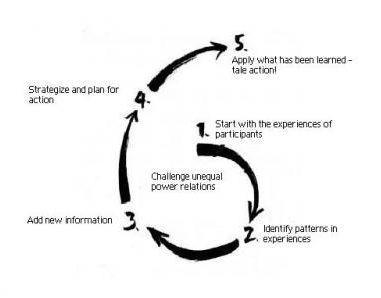Let’s get principled!
Module 3 discusses some key principles for popular education approaches to our union education work.
Read the short text below!
If you get stuck or have any questions, reach out. We’re here to help. Contact: education@cupe.ca

Popular Education – Key Principles
Begins with peoples’ experience
Popular education values and respects the experience and knowledge that the participants already have. Traditional programs often assume that workers come to the classroom with empty heads – and that the purpose of the education program is for the experts to fill those heads with information. Popular education starts with people’s experience and then adds new information and knowledge linked to what workers already know.
Encourages equitable participation
Popular education is concerned with uncovering power relations (of class, race, gender, age, sexual orientation, physical ability) both outside and inside the classroom. It encourages individual and collective action against inequities.
Has vision and long term goals
Popular education is concerned with helping workers adapt to changing international and local conditions. It is also concerned with building links both to workers elsewhere and to other parts of the social movement. Popular education is not just about what happens to union education classroom. It is a way of thinking and working that can be applied to organizing and other aspects of union life.
Links learning to action
Popular education helps workers develop the tools they need to analyze their situation and work out solutions to their own problems. The focus is on collective rather than individual action. At the end of a popular education process, people should be surprised by how much they know and feel more confident and empowered to act together.
Draws on the whole person
One important contribution of feminism to popular education is its focus on the whole person – the physical, spiritual and emotional as well as the mental dimension of learning. Denise Nadeau wrote that popular education “must do more than get people to think critically; it must wake up bodies and spirits numbed by overwork, exhaustion or the tyranny of the dominant culture.”
More than a cute set of techniques
Popular education does use a variety of tools and activities to give everyone an opportunity to participate and learn and to draw on people’s creativity. However, it is not just about participatory techniques and group dynamics. Rather, popular education is an approach which starts from and respects the workers’ knowledge and experience. It helps people develop critical skills for analysis and action as part of the wider process of organizing for social change and movement building.
Models and develops democratic practices
Popular education is deeply democratic. The teacher and the students both learn and teach. The goal is to help people name and create the vision of the new society they are trying to create and to make their voices heard. Canadian literacy educator Jean Unda calls popular education classrooms “liberated territory” where people get a chance to experience democratic practice firsthand. Workers also learn skills they can take with them into other parts of their union work.
- Excerpt from Popular Education: It’s alive and well in the labour movement by Bev Burke, Briarpatch, October 2000.
